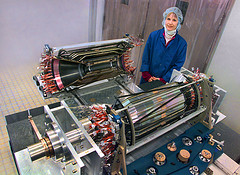May 19th, 2010 by Eugene Barsky | No Comments »

As recent article in NYT discusses new findings in the FermiLab – http://www.nytimes.com/2010/05/18/science/space/18cosmos.html?src=me&ref=general
The new effect hinges on the behavior of particularly strange particles called neutral B-mesons, which are famous for not being able to make up their minds. They oscillate back and forth trillions of times a second between their regular state and their antimatter state. As it happens, the mesons, created in the proton-antiproton collisions, seem to go from their antimatter state to their matter state more rapidly than they go the other way around, leading to an eventual preponderance of matter over antimatter of about 1 percent, when they decay to muons.
I could not find the relevant papers (that NYT referred to) in arxiv.org but many of the relevant papers are in the Web of Science database
** photo by http://www.flickr.com/photos/berkeleylab/
Posted in Astronomy, Main, Mathematics, Physics, Science - undegraduate classes | No Comments »
April 22nd, 2010 by Kevin Lindstrom | No Comments »
Newsmaker Interview:
Imponderables Complicate Hunt For Intelligent Life Beyond Earth
Dr. Paul Davies a professor at Arizona State University, Tempe discusses his role in the search for intelligent life beyond Earth.
Read the full interview here.
Other articles published by Dr. Davies include Are ALIENS among Us? Davies, Paul, Scientific American, Dec2007, Vol. 297, Issue 6, p62-69.
Submitted by Kevin Lindstrom Liaison Librarian for Physics and Astronomy at the University of British Columbia
Posted in Astronomy, Earth and Ocean Sciences, General Science, Geography, News, Physics, Science - undegraduate classes | No Comments »
February 11th, 2010 by Kevin Lindstrom | No Comments »
BOULDER—Painting the roofs of buildings white has the potential to significantly cool cities and mitigate some impacts of global warming, a new study indicates. The new NCAR-led research suggests there may be merit to an idea advanced by U.S. Energy Secretary Steven Chu that white roofs can be an important tool to help society adjust to climate change.
Read the National Center for Atmospheric Research (NCAR) news release here. The full article published in Geophysical Research Letters can be read here.
Submitted by Kevin Lindstrom Liaison Librarian for Earth and Ocean Sciences
Posted in Atmospheric Science, Civil Engineering, Earth and Ocean Sciences, General Science, Geography, Mechanical Engineering, Physics | No Comments »
December 18th, 2009 by Kevin Lindstrom | No Comments »
There are currently two very useful journal rankings SCImago and JCR. These rankings allow you to display amongst other things the h-index for a specific journal or a grouping of journals based on subject
“The SCImago Journal & Country Rank is a portal that includes the journals and country scientific indicators developed from the information contained in the Scopus® database (Elsevier B.V.).” Scopus contains more than 15,000 journals from over 4,000 international publishers as well as over 1000 open access journals. There are also over 500 conference proceedings in the database.
For more information, go to SCImago
“Journal Citation Reports® is a comprehensive and unique resource that allows you to evaluate and compare journals using citation data drawn from over 7,500 scholarly and technical journals from more than 3,300 publishers in over 60 countries.”
JCR Science Edition contains data from over 5,900 journals in science and technology.
JCR Social Sciences Edition contains data from over 1,700 journals in the social sciences.
For more information, go to JCR (Journal Citation Reports)
It is important to be aware of the size of the body of literature (the number of journals and conference proceedings) being indexed in Scopus and Web of Science. Journals listed in JCR are indexed in the Web of Science The larger the database, the greater the possibility that articles will be discovered, read, and hopefully cited. This is especially important for open access journals, some of which have not yet been indexed in the Web of Science.
Eigenfactor ranking is based on Web of Science data.
Submitted by Kevin Lindstrom Liaison Librarian for Science and Engineering
Posted in Astronomy, Atmospheric Science, Chemical and Biological Engineering, Chemistry, Civil Engineering, Earth and Ocean Sciences, General Science, Geography, Materials Engineering, Mathematics, Mechanical Engineering, Mining engineering, News, Physics, Science - undegraduate classes, Statistics, Uncategorized, Wood Sciences | No Comments »
December 15th, 2009 by Eugene Barsky | No Comments »

NYT today has an article on an issue of great importance to all science disciplines – data management. The article – “A Deluge of Data Shapes a New Era in Computing” overviews the new book published by Microsoft researchers – “The Fourth Paradigm: Data-Intensive Scientific Discovery.”
The book is available in full text from Microsoft here – http://research.microsoft.com/en-us/collaboration/fourthparadigm/4th_paradigm_book_complete_lr.pdf
This is a hot issue in science libraries too, as we are trying to understand how to deal with the vast amounts of digital data and whether libraries have a role to play to support, maintain and archive some of this data…
** photo by http://www.flickr.com/photos/nickwheeleroz/
Posted in Astronomy, Atmospheric Science, Chemical and Biological Engineering, Chemistry, Civil Engineering, Earth and Ocean Sciences, General Science, Geography, Main, Materials Engineering, Mathematics, Mechanical Engineering, Mining engineering, Physics, Science - undegraduate classes, Statistics, Wood Sciences | No Comments »
December 11th, 2009 by Kevin Lindstrom | No Comments »
Ron Simmer Patent and IP Expert has once agained issued his Patex Bizarre Patents Calendar.
This calendar documents the creative spirt of the human race reflected in patents.
Check out Ron’s excellent site of patent and intellectual property links at the Patex website.
Submitted by Kevin Lindstrom Science and Engineering Liaison Librarian
Posted in Amusing stuff, Astronomy, Atmospheric Science, Chemical and Biological Engineering, Chemistry, Civil Engineering, Earth and Ocean Sciences, General Science, Geography, Main, Materials Engineering, Mathematics, Mechanical Engineering, Mining engineering, News, People, Physics, Podcasts, Science - undegraduate classes, Statistics, Teaching, Uncategorized, Wood Sciences | No Comments »
December 4th, 2009 by Kevin Lindstrom | No Comments »
The AGU Digital Library is now available online. This collection gives you access to the archival content for the following AGU journals
| Earth Interactions |
1997–2004 |
| Geochemistry, Geophysics, Geosystems |
1999–2003 |
| Geophysical Research Letters |
1974–2003 |
| Global Biogeochemical Cycles |
1987–2003 |
| International Journal of Geomagnetism and Aeronomy |
1998-2003 |
| Journal of Geophysical Research |
1949–2003 |
| Terrestrial Magnetism |
1896–1898 |
| Terrestrial Magnetism and Atmospheric Electricity |
1899-1948 |
| Nonlinear Processes in Geophysics |
1994–present |
| Paleoceanography |
1986–2003 |
| Radio Science* |
1969–2003 |
| Reviews of Geophysics |
1963–2003 |
| Tectonics |
1982–2003 |
| Water Resources Research |
1965–2003 |
Online access to the AGU Digital Library is for UBC faculty, students, and staff only.
Submitted by Kevin Lindstrom Liaison Librarian for Earth and Ocean Sciences
Posted in Atmospheric Science, Chemistry, Earth and Ocean Sciences, Geography, Physics, Uncategorized | No Comments »
November 13th, 2009 by Kevin Lindstrom | No Comments »
Sociologist Joseph Hermanowicz’ new book Lives in Science How Institutions Affect Academic Careers describes how the prestige of academic institutions often shapes the career of the individual.
“For all but a handful of the scientists he studies, the prestige of their institution pretty much determines their professional–and even their personal–destiny. Of the more than 4000 institutions of higher learning in the United States where a scientist can get a faculty post–ranging from world-renowned research universities to local community colleges–only a very limited number possess the resources, reputation, and connections needed for research careers at the highest levels of recognition.”
Click here for a full review of Hermanowicz’ book.
Submitted by Kevin Lindstrom Physical Sciences and Engineering Liaison Librarian
Posted in Astronomy, Atmospheric Science, Chemical and Biological Engineering, Chemistry, Civil Engineering, Earth and Ocean Sciences, General Science, Geography, Main, Materials Engineering, Mathematics, Mechanical Engineering, Mining engineering, News, People, Physics, Science - undegraduate classes, Wood Sciences | No Comments »
November 12th, 2009 by Eugene Barsky | No Comments »
The newest issue of the Science has a short editorial titled “Becoming a Scientist“.
Personally, I found t his short piece to be very interested and not intuitive…take a look – http://www.sciencemag.org/cgi/content/full/326/5955/916?rss=1
Posted in Astronomy, Atmospheric Science, Chemical and Biological Engineering, Chemistry, Civil Engineering, Earth and Ocean Sciences, General Science, Geography, Main, Materials Engineering, Mathematics, Mechanical Engineering, Mining engineering, Physics, Science - undegraduate classes, Statistics, Wood Sciences | No Comments »


